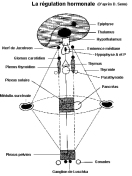Gesret method : reminders about embryology
Embryology: sheets
For a better understanding of the following page, a short reminder about
embryology seems useful.
Soon after fecundation the "morula" is formed, through cell division,
then rapidly develops into "blastula". During the third phase called
"gastrula" three sheets are roughly created.
Ectoblast
It covers the whole surface and steadily enlarges (ectoderm) then partly
invaginates to form the 4th sheet to be (neuroblast) from which the brain
and the nervous system will develop.
It will make up the skin with the dermoskeleton from the lateral
epiblastic sheet and the mesoencephalic system from the medial
neuroblastic sheet.
Chordo-mesoblast
It also goes deep inside and functions as a link with the ectoderm. Situated between the lateral and medial sheets it will constitute the spine segmental web, starting from the sella turcica to the caudal bud.

Mesoblast
It will constitute the different kinds of connective tissues (tendons,
apeunorosis, serous bursae, membranes, tendinous sheaths, adipic tissues,
cartilaginous dermis, osseous tissues).
It will also generate:
- heart and vessels musculature
- unstriped muscles
- sanguineous and lymphatic endothelium
- blood cells strains
- reticulo-endothelial tissue
- urogenital excretory system
- gonads
- all the tissues lining the colonus hollows
Endoblast
It distinctly individualizes at a deep level. These sheets are the womb
which will give birth to a group of organs and tissues.
It will constitute most of the endocrine glands such as anterior
pituitary gland, thymus, thyroid, parathyroid, pancreas, intestinal
glands and digestion and breathing organs.
Ganglionic crest
It will be constituted, in the mesoblast space, from the ectoblast, from
each side of the neural tube on the whole length of the notochord, as
metamerized bands to give the matrix of the sympathetic-parasympathetic
nervous system.
From the ganglionic crest the following will be constituted:
- cranial and spinal rachidial ganglions
- sympathetic ganglions and paraganglions
- parasympathetic paraganglionary chain
- pineal gland
- tympanic paraganglion (Jacobson's nerve)
- carotid glomus
- abdominal ganglion of Zukerkandel
- coccygeal paraganglion of Luschka
- medullo-adrenal
Sympathetic system
From ectoblastic origin, it runs through ganglionary relays and seeps into all the tissues, sending forth its axons into every cell. It has therefore got control over the whole body.
Central nervous system
 Everything that deals with the sensory motor system is related to the
thalamus through the bulb and spinal cord.
Everything that deals with the sensory motor system is related to the
thalamus through the bulb and spinal cord.
Everything that deals with the great neurohormonal drive goes through the
sympathetic system with its secondary relays such as the plexus and the
laterovertebral chain, coming from the anterior pituitary gland receiving
the fibers from the thalamus via the hypothalamus.
The supervision and the modulation of this organization are made through
the parasympathetic system and its ganglions.
The medullo-adrenal, acting as a real intervention station, has the
specific role of stabilizing the whole process. It is linked with the
solar plexus through the splanchnic. See diagram from D. Senn ->
Summary
Our endocrine glands, generally speaking, come from the endoblast. The
anabolic metabolism which regulates the whole body structural harmony, as
well as the adrenal cortex, come from the mesoblast.
Our five sense faculties, our brain, the whole nervous system (including
the pituitary gland posterior lobe) and the medullo-adrenal come from the
ectoblast, then from the neuroblast.
The endoblast is in charge of the assimilation of food material:
- digestion, breathing, discrimination of useless substances.
The mesoblast deals with metabolism:
- cell respiration, irrigation of blood, reserves stocking, pH control.
The dynamism depends upon the ectoblast:
- medial: central system (neuroblastic), cerebrospinal system
- lateral: the skin, linked to the central system by the vagosympathetic.
The disposal of wastes depends upon three sheets; the intestine and the lungs depends upon the endoblast; the urogenital system upon the the mesoblast; the skin (transpiration, thermoregulation) upon the ectoblast.
This whole extraordinary system is responsible for the body dynamism.
Commentary
At the skin level, that is to say the ectoblast, the 361 acupuncture
points are projected; they are distributed and arranged along two
extraordinary vessels and 12 meridians as well as the 36 points called
off meridians.
We therefore get 397 traditionaly codified points.
Some of them are designed for the analgesic treatment of local pains,
others for the treatment of functional visceral problems, with, for a few
of them, a bearing upon the treatment of behaviour or central system
problems.
I analyzed this extraordinary organization in an extensive research
published in "Acupuncture et Ostéopathie: vérité neurophysiologique".